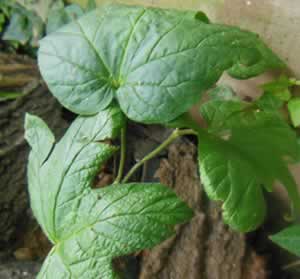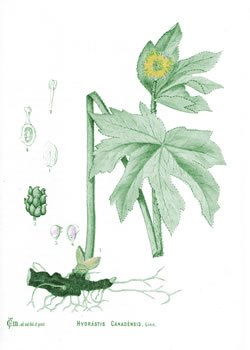Goldenseal Hydrastis canadensis

Young goldenseal leaves
- Common Names
- Goldenseal , Yellow Root
- Botanical Name
- Hydrastis canadensis
- Family
- RANUNCULACEAE
Medicinal Uses & Benefits of Goldenseal
![]() How to Use|
Side Effects |
Plant & Garden|
How to Use|
Side Effects |
Plant & Garden|
- Medicinal Uses: * Athletes Foot/Ringworm
* Bronchitis
* Colds
* Cuts & Wounds
* Diarrhea
* Eczema
* Eyes/Vision
* Gastritis/ulcer
* Immune
* Parasites/worms
* Psoriasis
* Sore Throat
- Properties: * Antibacterial * Antifungal * AntiViral * Bitter * Cholagogue * Hepatic * Immunostimulant * Vermifuge
- Parts Used: primarily the root, to a lesser extent leaves
- Constituents: hydrastine, berberine, berberastine, canadine, candaline, and hydrastinine, fatty acids, resin, polyphenolic acids, meconin, chlorogenic acid, phytosterins
How to Use: Goldenseal
Goldenseal is widely used in many herbal salves and ointments as a disinfectant. Goldenseal root contains berberine and hydrastine which have a broad-spectrum antibacterial and antiviral action. Duke The herb's primary value is as an infection fighter for upper respiratory congestion and sinus infections as well as a topical antibiotic in skin infections, cuts and wounds, sore throats, mouth ulcers, and eye infections.
Goldenseal is also a bitter herb that stimulates bile and can be used to improve digestive problems from peptic ulcers to colitis. It works well against diarrhea caused by intestinal bugs and can be used in formulas to treat intestinal parasites. Hoffman
Preparation Methods & Dosage : Tincture of goldenseal can be applied directly for infections and ulcers of the mouth. The leaves can be used as a antiseptic skin wash and applied in a poultice. Combines well with garlic as an anti-parasitic treatment. Goldenseal makes a good topical antiseptic for minor injuries. The powdered root can be made as an infusion, the chopped root should be simmered.
Goldenseal Remedies
Goldenseal Side Effects: Goldenseal is not for long-term use, and should not be used by pregnant,or lactating women. Avoid if you have high blood pressure. The tannins in goldenseal tinctures may cause stomach irritation, so you should avoid taking the herb in tincture form if you have diarrhea or chronic heartburn.
Plant Description

(Millspaugh, Charles F.,[9])
- Flower and Fruit:single, greenish-white, apetalous, asepalous flower. Sepals 3, pale-rose color, caduceus. Petals none. Stamens numerous; filaments linear or linear-spatulate; anthers oval, innate. Pistils numerous, twelve or more in a dense head; ovary i-celled, one- to two-ovuled; styles short; stigma flattened and dilated, one- to two-lipped. Fruit a succulent, globose berry
- Plant Class:Perennial Shrub, 6 to 10 inches high
- Leaves:leaves and fruit much resembling those of the raspberry. Leaves 2, alternate, near the summit of the plant, orbicular-cordate at the base, palmately five- to seven-lobed, the lobes doubly serrate, acute, veiny; attaining, when full grown during the fruiting season, a width of from 4 to 10 inches.
- Rhizome: Rhizome thick, oblong, irregular, and knotted, having a yellowish-brown, thin bark, and a bright-yellow interior; rootlets numerous, scattered, coriaceous fibres
- Flowering Season:
- Distribution and Habitat:Goldenseal once grew wild in the shady forests of eastern from Minnesota and Vermont south into Georgia, but the population has declined in the wild due to over harvesting and loss of habitat. Today the only remaining stands of wild goldenseal are isolated in the northern and central Appalachians and the Ozark mountains.
Regional Traditions :North America *
How to Grow Goldenseal
Goldenseal Hydrastis canadensis is on the United Plant Savers "At Risk" list. Wildcraft this plant responsibly and consider growing it if you have suitable garden space. Plant in a protected spot with deep, slightly acid loam soil and dappled shade.











